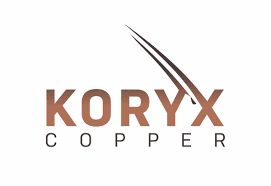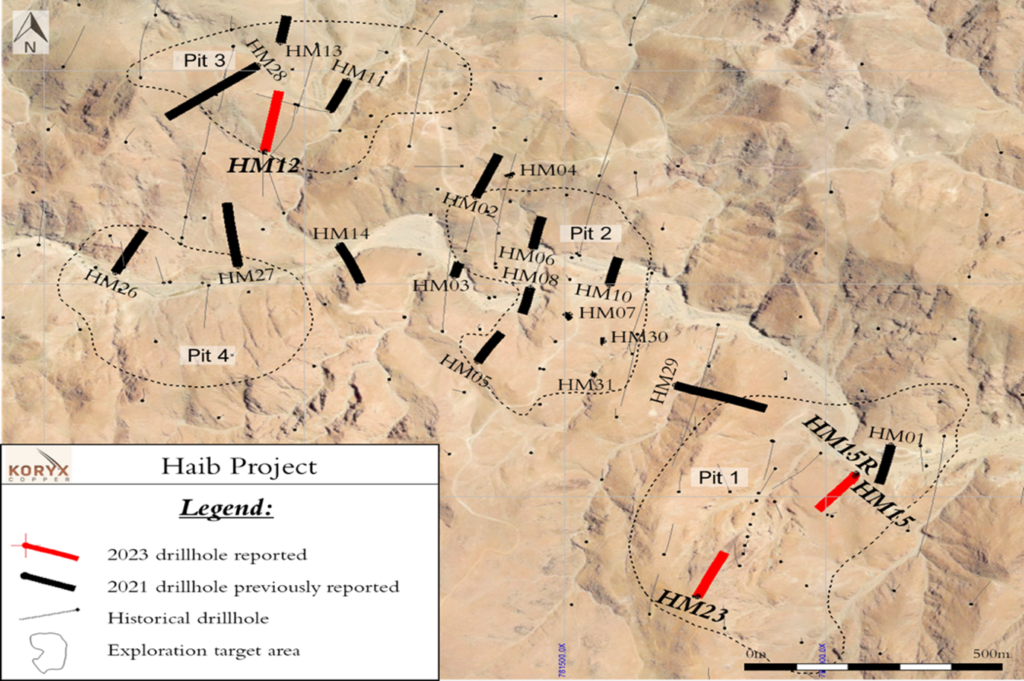
Koryx Copper Intersects 202 Metres at 0.49% Cu Eq, Including 4 Meters at 2.37% Cu Eq and 94 Metres at 0.61% Cu Eq at its Haib Deposit in Namibia
Significant copper and molybdenum intersections include:
- HM12: 0.76% CuEq over 20 metres including 4m @ 2.37% CuEq; and 0.49% CuEq over 202 metres including 94 metres @ 0.61 CuEq.
- HM15 : 0.94% CuEq over 12 metres from surface including 1.07% CuEq over 8 metres
- HM15R : 0.83% CuEq over 12 metres from surface including 0.95% CuEq over 8 metres.
- HM23 : 0.62% CuEq over 44 metres including 12m @ 1.12% CuEq and 0.53% CuEq over 28 metres.
Koryx Copper Inc. (TSX-V: KRY) announces the first assay results from its 2023/2024 drilling program at its Haib Copper project in southern Namibia. The Company’s latest four drill holes continue to confirm that the deposit can deliver high grades over substantial widths within the known historical resource.
Pierre Léveillé, President & CEO of Deep-South stated that: “We are extremely enthusiastic about the recent results from our drill program. These assay results continue to demonstrate that the Haib Copper Deposit has been seriously underestimated the average grade of the deposit by previous operators. Previous work estimated an average of 0.31% Cu, while recent work drilling has shown grades between 0.40% Cu Eq to 2.37% Cu Eq on extensions up to 200 meters.
Mr. Léveillé continues “Our drilling results are a game changer and will strongly add value to the overall copper deposit and to our shareholders.”
The 4 holes for which assay results are reported here cover some 874.13 metres with 1 hole (HM12) drilled in the Pit 3 area and the remainder in the Pit 1 area. All holes were positioned to better delineate the previously identified higher grade portions of the Haib Copper Project and to test the extension of grade between these targets. Assay results of significant intersections are tabulated below:
Significant Intersections
| Hole# | Zone | From | To | Width | CuEq | Cu | Mo |
| (m) | (m) | (m)1 | (%)2 | (%) | (%) | ||
| HM12 | Main | 76.00 | 96.00 | 20.00 | 0.76 | 0.74 | 0.005 |
| Including | 92.00 | 96.00 | 4.00 | 2.373 | 2.35 | 0.005 | |
| Main | 130.00 | 332.00 | 202.00 | 0.49 | 0.44 | 0.014 | |
| Including | 238.00 | 332.00 | 94.00 | 0.61 | 0.58 | 0.010 | |
| HM15 | Main | 2.00 | 14.00 | 12.00 | 0.94 | 0.93 | 0.003 |
| Including | 4.00 | 12.00 | 8.00 | 1.07 | 1.06 | 0.004 | |
| HM15R | Main | 0.00 | 12.00 | 12.00 | 0.83 | 0.81 | 0.005 |
| Including | 2.00 | 10.00 | 8.00 | 0.95 | 0.93 | 0.006 | |
| Main | 58.00 | 64.00 | 6.00 | 0.55 | 0.52 | 0.008 | |
| Main | 90.00 | 112.00 | 22.00 | 0.35 | 0.34 | 0.003 | |
| HM23 | Main | 120.00 | 164.00 | 44.00 | 0.62 | 0.60 | 0.007 |
| Including | 152.00 | 164.00 | 12.00 | 1.12 | 1.09 | 0.008 | |
| Main | 198.00 | 226.00 | 28.00 | 0.53 | 0.49 | 0.012 | |
| Main | 274.00 | 296.00 | 22.00 | 0.49 | 0.48 | 0.002 | |
| Including | 280.00 | 288.00 | 8.00 | 0.62 | 0.61 | 0.004 | |
| Main | 316.00 | 322.00 | 6.00 | 0.52 | 0.52 | 0.001 |
- Width refers to intersection width; true widths have not been determined.
- CuEq (copper equivalent) has been used to express the combined value of copper and molybdenum and is provided for illustrative purposes only. No allowances have been made of recovery losses that may occur should mining eventually result. Calculations use metal prices of US$3.00/lb copper, US$10/lb molybdenum using the formula: CuEq% = Cu% + (Mo% [$10/$3])
- This CuEq grade was previously reported as 2.57. The corrected CuEq grade is 2.37.
Note: Mineral Resources are not Mineral Reserves and do not have demonstrated economic viability as may be obtained once a pre-feasibility or feasibility studies have been completed and all modifying factors have been taken into account. The estimates do not account fully for mineability, selectivity, mining loss and dilution. These estimates contain inferred Mineral Resources that are considered too speculative geologically in terms of grade continuity between drillholes to have the economic considerations applied to them to be categorized as mineral reserves.
Borehole Locations (Figure 1)
Figure 1 : Planview showing the positions of the boreholes being reported here.
HM12 was drilled northwards in Pit 3 to better delineate the southern limit of the high-grade mineralisation identified here by reducing the drillhole spacing.
HM15 was positioned in Pit 1 and drilled at a shallow angle (-45°) towards the southwest. The purpose of this hole was to test the downdip extension of the shallow high grade Cu mineralization identified by the close spaced historical drilling to the southwest and above the adit. Due to the drill pad collapsing, the hole was abandoned at 36m.
HM15R is the redrill of HM15 positioned 9m further south.
HM23 was drilled towards the northwest in Pit 1. Its primary purpose was to close the intersection spacing and to understand spatial changes from the shallow high-grade mineralization in HB006 to the north (~20m deep) and the deeper intersections in HM22 to the south (96m).
Discussion of Pertinent Results
HM12
Assay results for the first 96m of this hole had been received in 2021. With the resumption of activities in October 2023, the remaining samples were submitted to the laboratory. The full results show that the high-grade interval (>0.74% Cu) from 76m to 96m that was reported previously is spatially separated from the main Pit3 high grade mineralization which was intersected from 130m to 332m. The relationship between the two is not clear but the first intersection could be a bulge-like extension of the main mineralization or a cross cutting structural feature.
HM15 and HM15R
Drilled in the dry river bed, the original hole was abandoned at 36m due to the drilling pad collapsing. The redrill was positioned some 9m south. In both holes, high grade (>0.8% Cu) mineralization was intersected from surface for about 12m with a peak grade over 2m of 1.35% Cu. This correlates spatially with the shallow dipping high-grade zone intersected by the close-spaced historical drilling some 240m to the southeast. Two other narrower zones were intersected with the most significant ~100m below topography exhibiting and average Cu grade of 0.34% over 22m. This intersection also correlates spatially with the close spaced historical drilling above the adit. Mo grades in all instances are very low which is fairly typical of this area.
HM23
High grade mineralization was first intersected some 85m below topography for 44m at 0.6% Cu and including 12m over 1% Cu (peak grade of 1.44% Cu). This confirms the downward displacement of the shallow high-grade zone south of the line of close spaced holes. Two other high-grade zones with Cu grades just under 0.5% were intersected over 28m and 22m respectively. A third zone of 6m at 0.52% Cu was intersected deeper. These lower zones correlate spatially well with HM22 and HB006. Mo is well developed for portions of the hole with one intersection averaging 0.013% Mo over 60m from 120m below topography.
Drilling Program Update
At the cessation of activities in 2021, twenty-two boreholes had been completed totaling 4,610.81m of the planned 10,000m.
Nineteen of these holes had been completely assayed, and one only partially assayed. The drilling of HM23 was only partially done. All available results were disclosed in July and August 2023.
Activities resumed in October 2023 with a planned drilling programme of 4,000m focused on the Pit1 area. The outstanding samples from the 2021 programme were immediately submitted to the laboratory. Since the start of the programme, 7 boreholes (1,320m) have been completed. Five have been fully sampled and submitted to the laboratory. Assay results for 3 along with the HM12 results (sampled in 2021) were received in January 2024. Currently, samples for 2 boreholes are at the laboratory while a further 2 await dispatch.
At 1.8 billion years (Archean), the Haib Copper Deposit is one of the oldest deposits in the world. Over time, it has seen several transformations including shearing and faulting events that appear to have further concentrated Cu and Mo. A number of these mineralized structures have been identified in the Pit1. The revised drilling programme looks to close the sample spacing in the Pit1 area and better delineate the extent and grades of these.
Quality Control
All drill cores were logged, photographed, and cut in half with a diamond saw. Half of the cores were bagged and sent to ALS Laboratories Ltd. in Johannesburg, South Africa for analysis (SANAS Accredited Testing Laboratory, No. T0387), while the other half was quartered with one quarter archived and stored on site for verification and reference purposes while the other quarter will be used for metallurgical test work. 33 elements are analyzed by Induced Coupled Plasma (ICP) utilizing a 4-acid digestion and gold is assayed using a 30g fire assay method. Duplicate samples, blanks, and certified standards are included with every batch and are actively used to ensure proper quality assurance and quality control.
Qualified Person
Mr. Dean Richards Pr.Sci.Nat. , MGSSA – BSc. (Hons.) Geology, is the Qualified Person for the Haib Project as defined by National Instrument 43-101 and has approved the technical disclosure contained in this news release.
About the Haib Copper Project
The Haib Copper Deposit is a large copper/molybdenum deposit situated 40 kilometers from the southern boundary of Namibia. The license covers 370 square kilometers (37,000 hectares). Over the years the project has seen 70,000 meters of drilling, several metallurgical test work programmes, geophysical surveys, geological mapping, mine modeling and even a feasibility study in 1996. Deep-South holds all the historical data.
About Deep-South Resources Inc.
Deep-South Resources is a mineral exploration and development company. Deep-South’s growth strategy is to focus on the exploration and development of quality assets in significant mineralized trends and in proximity to infrastructure in stable countries. The Company holds the Haib Copper Project in Namibia and holds an interest in three exploration licences in the Copperbelt in Zambia. In using and assessing environmentally friendly technologies in the development of its copper projects, Deep-South embraces the green revolution.
MORE or "UNCATEGORIZED"
Quimbaya Gold Closes $4 Million Financing and Expands Executive Team
Cornerstone investor brings proven regional track record; company... READ MORE
Spanish Mountain Gold Announces Larger Scale Preliminary Economic Assessment With a Base Case NPV5% After-Tax of C$1.0 Billion, 18.2 % IRR and 3.4 Year Payback at US$ 2,450/Oz Gold Price; at US$3,300/Oz Spot Gold Price NPV5% C$2.3 Billion, 32.0% IRR and 2.0 Year Payback; Including an Updated Mineral Resource Estimate for Its Spanish Mountain Gold Project
Spanish Mountain Gold Ltd. (TSX-V: SPA) (FSE: S3Y) (OTCQB: SPAUF)... READ MORE
Aura Announces Preliminary Q2 2025 Production Results
Aura Minerals Inc. (TSX: ORA) (B3: AURA33) (OTCQX: ORAAF) is plea... READ MORE
Cascadia Announces Closing of Financing
Cascadia Minerals Ltd. (TSX-V:CAM) (OTCQB:CAMNF) is pleased to an... READ MORE
Abcourt Closes US$ 8M Loan Facility to Start Sleeping Giant Mine
Abcourt Mines Inc. (TSX-V: ABI) (OTCQB: ABMBF) is pleased to anno... READ MORE














